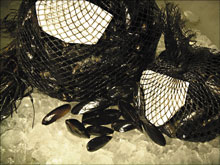 Mussels are a mainstay on many restaurant menus throughout the state of Maine. Their regular availability, affordable price, and ease of cooking make them a desirable and profitable commodity for restaurant owners. The advent of rope-cultured mussels in recent years has dramatically improved the quality and consistency of this delectable bivalve. They are meatier, more tender, less muddy in flavor, and certainly less apt to contain grit than their wild counterparts. Mussel farmer Tiffany Craig explains that because farm-raised mussels lead an easier existence, not having to battle ocean currents to cling to rocks and such, their meat reflects a “life of luxury.”
Mussels are a mainstay on many restaurant menus throughout the state of Maine. Their regular availability, affordable price, and ease of cooking make them a desirable and profitable commodity for restaurant owners. The advent of rope-cultured mussels in recent years has dramatically improved the quality and consistency of this delectable bivalve. They are meatier, more tender, less muddy in flavor, and certainly less apt to contain grit than their wild counterparts. Mussel farmer Tiffany Craig explains that because farm-raised mussels lead an easier existence, not having to battle ocean currents to cling to rocks and such, their meat reflects a “life of luxury.”
Tiffany, who works for Tollef Olson, producer of the well-known Bangs Island mussels, describes the year-round process of mussel farming. The three-person crew heads out of Portland at 6 am on a small skiff to Bangs Island (by Chebeague in Casco Bay) where a 20-foot-by-60-foot barge is moored. After switching boats, they pull up to the rafts, which are sheltered by part of the island. These semi-permanent rafts have numerous ropes hanging about forty feet down into the ocean on which the mussels thrive. The mussels are first introduced as “seeds” (very small free-floating mussels), which are gathered from the nets surrounding the rafts at Bangs Island, and collected from the Blue Hill Salt Ponds. These seeds are then held in close contact with the ropes using long sock-like mesh around each rope. They take sixty to ninety days to attach to the ropes and then another fifteen months to mature.
The mussels themselves feed mainly on plankton, which is abundant in the ocean water. Ducks are the main predator in this particular area, and if able to evade the nets surrounding the rafts, the ducks can devour enormous quantities of mussels in a very short period of time. The other main factor that can thwart the mussel farming is red tide, a toxic algae bloom, which can contaminate the shellfish, halting the harvest completely.
A winch on the barge is used to haul up the mussel-laden ropes as the workers knock the mussels free of the rope and into the sorter on the boat. They are given their first washing with salt water there on the barge. After a rigorous four- to six-hour haul of three to four thousand pounds of mussels, they return to the mainland where the mussels are sent through the debysser (a machine which removes the “beards”). They are then sprayed with fresh water to remove more dirt and other particles. From there they go to the grading table where they are separated according to size and any broken or undesirable ones are removed. Next, they are packed on ice and make their way to fish markets and seafood distributors in Maine and elsewhere.
Your way
Though mussels are very versatile culinarily speaking, it seems as though many restaurants get hung up on the traditional routine of cooking them with garlic, white wine, butter, and maybe some herbs, tomatoes, or nuts. While these tried-and-true preparations can be very delicious, it’s nice to see chefs stray a bit from the norm. The following is a version of chilled marinated mussels that will really wake the taste buds. It may be served as an appetizer with crostinis or hard crackers; it also works very well as a topping for a piece of salmon, halibut, or swordfish.
 Related
Related:
Twenty-spot, West End meals, Origami appetizers, More 
- Twenty-spot
With the persistent rain dampening my sense of adventure and spirits, I consolidate my shopping in the best guaranteed all-you-need-in-one-place market, the Rosemount Bakery on Brighton Avenue.
- West End meals
The West End of Portland is often considered highbrow, high-rent, and full of high expectations.
- Origami appetizers
Welcome to a tasty morsel of Somalian life.
- Myers+Chang
Chinese restaurants have given us so much flavor and value that it seems almost rude to point out that Boston hasn’t had a lot of luck with making them upscale.
- The iPhone of markets
Residents of Munjoy Hill got a Christmakwanzakkah present early this year in the form of Fat Baxter’s East End Market.
- Tresca
In an uncertain market where most operators are looking down, the owners of Tresca decided to raise prices. Food begins justifiably exquisite.
- Home-cooked satisfaction
Trips to my mom’s house always involve her spoiling me and my friends with Georgia-born home cooking.
- Everything is coming up bacon
Pigs are noble creatures, selflessly giving of their delectable flesh — and we need as many of them as we can get.
- A compendium of regional recipes and tasty tales
May your head dance with visions of sugarplums.
- Senses and sensibility
February is the month of love, and the shortest month on the calendar.
- Cold comfort
Like any good codependent, frozen food’s effects are soporific. It prolongs and deepens our suffering even as it makes it bearable.
- Less

 Topics
Topics:
Restaurant Reviews
, Culture and Lifestyle, Beverages, Food and Cooking, More  , Culture and Lifestyle, Beverages, Food and Cooking, Foods, Fruits and Vegetables, Seafood, Wine, Recipes, Main Dish Recipes, Less
, Culture and Lifestyle, Beverages, Food and Cooking, Foods, Fruits and Vegetables, Seafood, Wine, Recipes, Main Dish Recipes, Less 